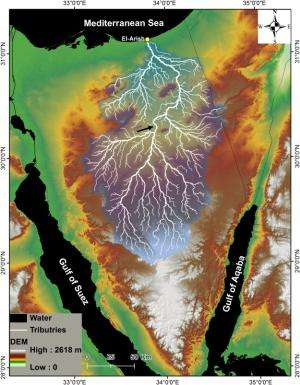Bringing water to the Sinai?

According to a new study co-authored by CAS researchers, the traces of an ancient watershed in the Sinai Desert may hold clues to making sustainable agriculture possible in one of the driest places on earth. Farouk El-Baz, research professor and director of BU's Center for Remote Sensing, and Mostafa AbuBakr, a visiting scholar at the Center, were part of an international team of scientists who used advanced space-borne radar to reveal how water flowed through the Wadi El-Arish in less arid times—about five to ten thousand years ago. That discovery opens the possibility of capturing water from seasonal downpours by channeling it to the Wadi's central basin. Their findings appear in the April 2013 edition of the journal Geomorphology.
The Egyptian Sinai Peninsula, an extension of the Great Sahara, is among the driest deserts on Earth, but that wasn't always the case. Geological evidence indicates that the Eastern Sahara has undergone climatic fluctuations of wet and dry episodes over the last two to three million years, with the last major wet cycle occurring between 9,500 and 4,500 years ago.
Wadi El-Arish is one of the ephemeral rivers that were active during these wet phases, although at present, the tributaries of Wadi El-Arish are dry, channeling the occasional flash flood northward over the central carbonate plateau of Sinai, toward the Mediterranean Sea at El-Arish City. Although northeastern Sinai receives the largest amount of rainfall in Egypt (~ 304 mm annually), lack of freshwater resources continues to impede sustainable development in the Sinai.
Because Wadi El-Arish has the largest watershed in the Sinai and collects over 60 percent of the peninsula's precipitation, it is being closely studied for its potential to make possible sustainable agricultural development in North Sinai, based on the renewable runoff and the potential groundwater of its paleolakes. The success of this process depends on identifying and using the ancient course of the Wadi to channel and capture this runoff.
The present study used remote sensing and geographic information systems (GIS) to delineate the former shape and flow direction of Wadi El-Arish before recent uplifting and explain the causes that led it to deviate from its original course. The study also mapped paleolakes along the former river course and estimated the amount of water held in the lakes. An important outcome of this study includes establishing an approach that integrates remote sensing data, geomorphology and geological structure to understand the paleodrainge evolution and its implications on groundwater potentiality, which could be applied to the study of arid lands around the world.
The researchers used space-borne radar images, provided by Radarsat-1 and the Shuttle Radar Topography Mission (SRTM), to recognize paleodrainage features. Optical satellite images by the Landsat ETM + and the high-resolution images of GeoEye and Spot 5 satellites aggregated in Google-Earth (www.google.com/earth) were also used as supplementary data. The optical data were employed for visual interpretation of surface features and paleolake sediments.
The researchers identified the former main channel course of Wadi El-Arish west of Gebel Halal, and three major paleolakes were defined within structurally controlled depressions. They used ground penetrating radar to confirm the findings of the radar satellite images. The simulation of the paleotopography was also confirmed by field observations and led to a concept for improved management of the renewable water resources in the study area. Based on these findings, the researchers recommend establishing a two kilometer long canal with a depth of six meters within the structural uplift. This canal would redirect the occasional runoff to a vast flat area west of Gebel Halal to provide water for approximately 1400 square kilometers of fertile land for agricultural development. The flow redirection would also help to mitigate the negative effects of flash floods in El-Arish City and maximize the harvesting of rainwater that would otherwise be lost to the sea.
The region in between Gebels Halal, Yelleg and El-Maghara represents a promising area for agriculture development with considerable amounts of surface clay minerals supplied from the Esna shale deposits. Moreover, this area contains relatively low groundwater salinity, and the deep groundwater aquifer of the early Cretaceous Nubian Sandstone has been brought close to the surface by anticlinal folding.
Although encouraged by their findings about the course of the Wadi, addition work remains to be done. "Aspects of the geomorphic evolution of Wadi El-Arish, the largest ephemeral drainage system in the Sinai Peninsula, are still ambiguous, and its paleochannels remain undefined," says AbuBakr.
One of the obstacles that impede recognition of these paleodrainage features is the variation in topography from past to present. "Some of this variation is attributable to the post Miocene tectonic activity in the region. This activity might have continued to the present, and led to developing an alternative course for the paleoriver," says El-Baz. "The folded Syrian Arc Belt in North Sinai had a significant influence on the shape and direction of Wadi El-Arish. Anticlinal ridges appear to have formed natural barriers that blocked the water flow across the main drainage course during humid periods, and forced Wadi El-Arish to deviate from its original course."
More information: www.sciencedirect.com/science/ … ii/S0169555X13001992
Journal information: Geomorphology
Provided by Boston University


















